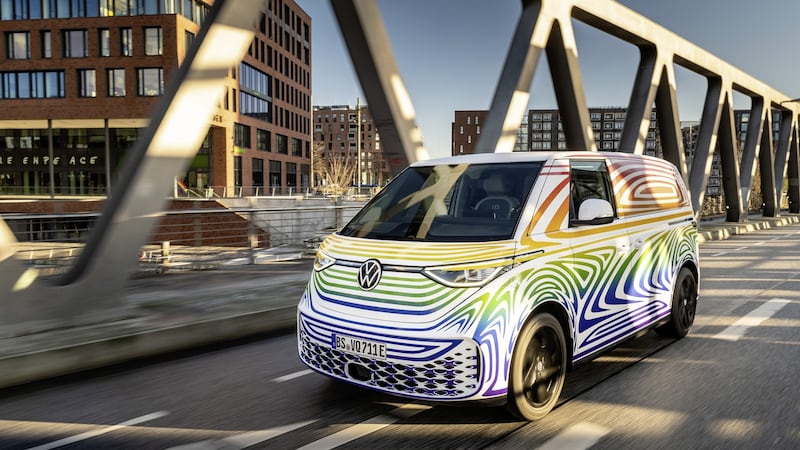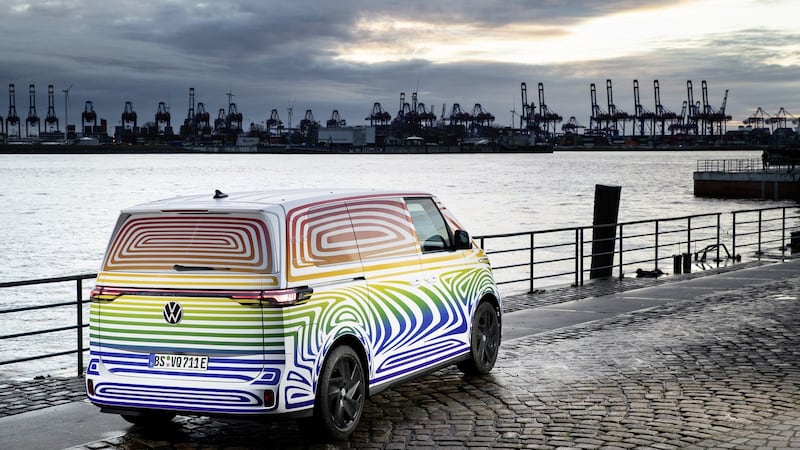Amid the revolutionary upheaval in the motor industry, Volkswagen is hoping it can get an edge on newcomers by tapping into some retro appeal.
Early next month Volkswagen will fully reveal its much-hyped all-electric ID Buzz to the world. Its retro design blatantly taps into a rich vein of nostalgia, paying homage to the famed VW T1 ‘Bulli’ van.
In its latest guise, the ID Buzz will initially arrive as a five-seater or a commercial ID Cargo van.
Both variants feature an 82kWh (77kWh net) rechargeable battery and a 150kW (200hp) electric motor.
Later this year a longer-bodied, seven-seat version will launch. It will have a larger battery with a driving range of about 500km.
Like the famed favoured transport of generations of hippies, the ID Buzz has a rear-mounted motor powering the rear wheels.
Ahead of launch, we took to the mellow streets of England's Milton Keynes to test drive a couple of disguised pre-production models.
Scalable platform
The Buzz is built on VW’s scalable MEB electric car platform that underpins the ID car range – and the soon-to-arrive ID 5.
It’s the largest ID version yet but VW says it will have similar charging and range capabilities next to other ID models with the same size battery.
It’s a big, broad, brute of an EV, yet ever so cute. Its cab-forward exterior design and very short front and rear overhangs deliver that microbus look. In a classic VW Bulli the driver’s toes can almost touch the front bumper; needless to say, this proximity is less than ideal in a collision.

Closer inspection reveals the same design trick VW performed with its 1997 ‘new Beetle’. The windscreen glazed area has been moved far froward, with the cabin and driver remaining in the previous county. The driver sits behind and not over the front wheels.
From the driver’s seat you can still see the top of the very short bonnet and this helps with vehicle positioning. The dash-top area is so vast you could probably get an EU grant for land set-aside.
The ID Buzz is nearly two metres wide, similar to a typical VW Transporter van and fills up an urban lane. To put that width in context, a five-seat VW ID 4 is positively slim at 1,852mm.
The Buzz looks long but at 4,712mm is surprisingly shorter than a VW Tiguan AllSpace (4,728mm) or Tesla Model Y (4,750mm), making it more car-park friendly.
Its sliding rear doors are also excellent for tight access. At 1,937mm it is taller than a traditional full-size MPV yet lower than a 1,990mm VW Caravelle passenger van. VW says its relatively low height is to ensure car-like access to height restricted car parks, which will be welcomed by its core family market.
The vast cabin comes courtesy of a long wheelbase (2,988mm) and all occupants enjoy commanding and relaxing views. Rear passengers get large adjustable seats and acres of room. The boot is vast at 1,121 litres – and that’s with the rear seats in place.
Whether you need a five-seater with all this space with a circa €60,000 price point is a question only you can answer.
Inside our pre-production test car, bulky covers concealed some yet to be signed off interior design elements, but some splashes of colour hinted to the sense of fun we can expect.
Driving controls
First up we took the ID Buzz out on the roads. The driving controls are familiar from the other ID models. The automatic gearbox selector has the same ‘B’ setting for brake regeneration. The amount of brake force is decided by the driving mode chosen and also the state of the car’s battery charge at any given time.
The electric powertrain is simple and effortless to use, as one would expect from any EV. Even with sturdier front pillars to see around, the visibility up front is excellent.
A tall driving position combined with a blocky shape with near-vertical sides make it easy to position the EV on the road (our test vehicles were left-hand drive).
The famed roundabouts of Milton Keynes were easily dispatched. On a variety of surfaces, including some quite poor B roads, the suspension delivered a composed and comfortable ride.
The ID Buzz may be a large block, but it is very manoeuvrable with a surprisingly tight turning circle of just over 11m, similar to a VW Golf. There are the usual array of driving modes, with comfort the default setting and, of course, an eco mode to gain maximum driving range.
Acceleration is impressive, if a little exaggerated due to the high seating position. The 200hp/310nm electric motor is integrated into the rear axle and top speed is limited to 145km/h. Other performance data stats will be released at launch.
Cargo variant
We also tested the commercial ID Cargo variant. The electric van qualifies for an SEAI grant of €3,800 and will retail for about €50,000 net, including VAT.
It features a three-seat bench format (or two individual seats) in the front and has a 700kg load capacity. The cargo area is separated by a full-height bulkhead. The rear deck can take two Euro pallets.

The Cargo gets a factory-fitted tow hitch as standard and VW offers an optional railed floor and strongly recommends owners fit specific ID-approved lightweight racking. EV vans require extra caution when drilling/fitting shelving, etc, much more so than a typical diesel van.
The ease of use is the most appealing thing with ID Cargo. VW stressed its electric commercial was designed from the off as an EV and is not a modified diesel van re-engineered to be an EV.
In general, any electric van’s driving experience is superior to a diesel (range excluded) yet the ID Cargo experience is better again. With a projected range of about 300km from a full charge with a load, the Cargo should attract a steady stream of Irish commercial customers.
One notable downside, however, is the likely inability to adapt or convert the ID Cargo for wheelchair access due to its rear-mounted motor and underfloor rechargeable battery pack. Most conversions require cutting into a vehicle’s rear axle and floor.
The ID Buzz and Cargo are connected cars and are prepped for over-the-air software updates. A host of driving-assistance aids will be available, one of note is park assist plus with an ability to carry out memorised parking manoeuvres.
Volkswagen’s new ‘plug and charge’ intelligent charging is set to feature in both Buzz and Cargo too at some stage, an innovation that makes charging cards superfluous. When you plug in to a public charger the car automatically identifies itself and the charger operator then directly bills the registered owner. Bidirectional charging will also be possible with a suitable DC wallbox and home energy-management system.
The passenger ID Buzz will be available in 32 VW dealerships in the Republic, with the ID Cargo available in its 24 VW van centres.
Pre-booking will open shortly. A cheaper 55kWh version is expected in Ireland at a later date. Alan Bateson, brand director of Volkswagen Commercial Vehicles, said he expected the initial buyers would be private owner/operators.
The ID Cargo is a significant vehicle on the road to mass adoption by the commercial sector of zero-emissions vehicles. Bateson pointed out a diesel VW Caddy Maxi produces 16.1 tonnes of CO2 over three years or 100,000km. Apart from the emissions created to produce the electricity needed to run an ID Cargo, it will produce zero emissions at the point of use.
The industry-wide supply crisis will undoubtedly dog the launch of this retro VW, but from our first impressions on the road, the ID Buzz lives up to the hype.





















